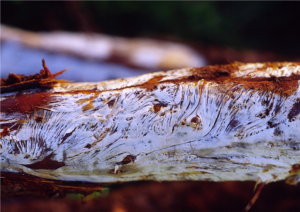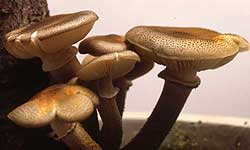The disease and its impact
Armillaria root rot is mainly caused by a native fungal species, Armillaria luteobubalina whereas overseas the most common cause of this disease is the closely related fungus Armillaria mellea. Both species exist in Australia. The fungus can infect at least 200 plant species and is also a significant pathogen of native forestry. Because of this, the disease is often seen where bush has recently been cleared and an orchard block planted. Pome and stone fruit, native trees, ornamentals and other plants are affected. The disease causes a decline in tree health without being obvious until dieback starts to become evident. The fungus has the common names “Bootlace”, “Shoestring fungus” due to the appearance of rhizomorphs, and “Honey toadstool” due to the colour and shape of the fruiting bodies.

Sheets of white mycelial ‘fans’ under the bark of an infected root (Photo: Agriculture Victoria)
Symptoms and life cycle
Growers will notice the above-ground symptoms of the disease first. The symptoms are like those of other root rot diseases: leaves yellow and fall prematurely and the tree shows ill-thrift, limbs dieback and the entire tree may die. Better diagnosis requires a closer look. Upon scraping away bark on the rotted stems and roots a white felt-like mate of fungus is revealed. This is often fan-shaped in appearance and smells like mushrooms.
The rhizomorphs can infect living trees but the spores that produce the rhizomorphs can only infect dead wood. The spores are produced by toadstools that grow at the base of dead or dying trees. The caps of the toadstools are scale-covered and a deep brown to honey colour, while the gills underneath the cap are whitish. The stems of the toadstools are a yellow-brown colour, have an obvious ring or collar at the top and may be up to 15 cm high. The toadstools appear in the dying stages of the host tree and usually during wet weather between May through July. Olive brown to yellow clusters of toadstools are sometimes seen growing from the base of dead and rotting trees during the period from May to July. These toadstools can be up to 12 cm in diameter with a stipe (stalk) of up to 15 cm high, although usually less. Soil conditions that favour the development of the disease are not well understood. It is thought that the fungus prefers lighter soils or clays with reasonable drainage and the disease can be very serious in the Stanthorpe region Any form of stress is thought to predispose trees to infection and both flood and drought have been implicated as contributing to disease severity. The fungus can survive in soil for extremely long periods of time (up to 20 years).

Honey-coloured toadstools (with scales on the cap and a pronounced collar) formed at the base of an affected tree (Photo: Agriculture Victoria)
Control
When clearing and planting new ground
• Ring-bark native trees and leave them for at least six months before removing them, so that starch reserves in the tree are depleted. This lowers the chance of such trees becoming centres of infection.
• Rip the area thoroughly and remove and burn all stumps and large roots.
• Leave the area under pasture for at least two to three years to allow small roots to rot.
When treating slightly affected trees
• Remove soil from around the butt and main roots to a radius of about 750 mm. A highpressure jet of water from a spray pump is a convenient way to remove soil from around affected trees. Cut out and burn diseased bark and roots, and paint cuts with a plastic paint. Leave the crown and roots permanently uncovered and do not replace the soil during cultivation. This will halt the disease, as exposure to air kills Armillaria.
• Remove and burn all badly affected trees, including roots.
Treatment before replanting severely affected trees
• Map the affected area to find the extent of the infection within the orchard. Include all trees showing poor growth, all replants within the area plus two rows of apparently healthy trees adjacent to the affected area. Trees can be checked for infection by exposing the roots and butts, as described above, and by removal of a small piece of bark from this region. On infected trees this will reveal a creamy white mycelial fan. If rhizomorphs or mycelial fans are found on any apparently healthy trees, then adjacent trees should also be checked as well.
• Remove all of the affected trees within the area, and as many roots as possible, and burn them on the spot. Do not move this material from the site, or cultivate outwards from the affected area, as the disease spreads readily through infected roots and stems.
• Plant a cover crop and allow time for any fine roots which remain in the soil to rot down completely before replanting.
• Monitor carefully for any signs that disease is reappearing.
More information
Armillaria root rot. State of Victoria, Agriculture Victoria. https://agriculture.vic.gov.au/biosecurity/plantdiseases/fruit-and-nut-diseases/stone-fruits/armillaria-root-rot
Acknowledgements
This article is republished from the Australian Apple and Pear IPDM Manual (2019 edition, HortInnovation), prepared by David Williams1 and Oscar Villalta1 with contributions by Stephen Quarrell2, Kevin Dodds3, Paul James4, Alison Mathews5 and Stewart Learmonth5
1 Agriculture Victoria; 2 TIA; 3 NSW DPI; 4 Lenswood Cooperative, 5 DPIRD WA
Images in this chapter were obtained with permission from
• William Jacobi, Colorado State University, United States
• Joseph O’Brien, USDA Forest Service, United States
• Andrej Kunca, National Forest Centre – Slovakia, Slovak Republic
